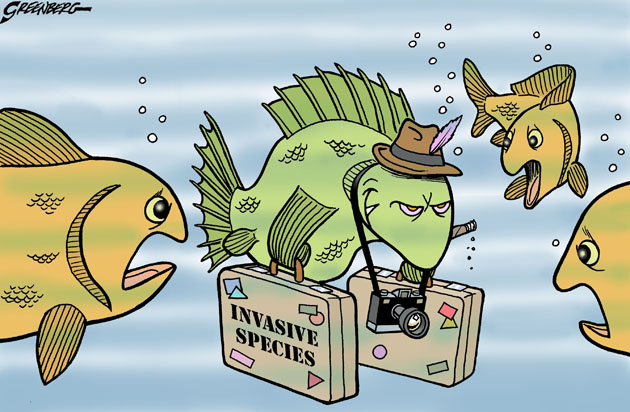What are invasive species?
- Invasive species are usually non native in nature and appear to have specific traits or specific combinations of traits that allow them to out-compete native species.
- Fast growth, rapid reproduction, high dispersal ability, phenotypic plasticity etc are the major traits exhibited by the introduced species which may turn themselves out to be invasive with their capability to out compete the native species for resources, such as nutrients, light, physical space, water or food.
- Human interference in the form of water ballasts or transmittal of species for pest control or aesthetics provide repeated chances for establishment of the introduced species with its low population in the new environment.
- According to IUCN, Alien invasive species" means an alien
species which becomes established in natural or semi-natural ecosystems or
habitat, is an agent of change, and threatens native biological diversity.

Why invasive species pose a problem to the
ecosystems?
- Invasive species can change the functions of ecosystems.
- For example, invasive plants can alter the fire regimen
(cheatgrass, Bromus tectorum), nutrient cycling (smooth cordgrass Spartina
alterniflora), and hydrology (Tamarix) in native ecosystems.
- Invasive species can impact outdoor recreation, such as fishing,
hunting, hiking, wildlife viewing, and water-based activities.
- Invasive species will adversely affect agricultural productivity,
health and economy as a whole apart from its deleterious effects on bio
diversity.
- Encroachment of humans into previously remote ecosystems has
exposed exotic diseases such as AIDS virus to the wider population.
 |
Introduced birds (e.g. pigeons), rodents and
insects (e.g. mosquito, flea, louse and tsetse fly pests) can serve as vectors
and reservoirs of human afflictions. Genetic pollution is another after effect
as the invasive species tend to hybridize the filial generations. Once
introduced, it is very difficult to control the expansion of invasion and hence
prevention is the most desired step in managing the invasive species.
Eradication is a tedious task involving huge cost constraints and sometimes may
not be successful.
Guidelines provided by IUCN for management at
international level
# Implement the provisions of
international treaties, whether global or regional, that deal with alien
invasive species issues and constitute a compulsory mandate for respective
Parties. Most prominent among these treaties is the Convention on Biological
Diversity, and a number of regional accords.
# Implement decisions taken by Parties to
specific global and regional conventions, such as resolutions, codes of conduct
or guidelines related to introductions of alien species, for example the
International Maritime Organisation's guidance on ballast water.
# Consider the desirability, or as the case may
be, necessity, of conducting further agreements, on a bilateral or multilateral
basis, or adapting existing ones, with respect to the prevention or control of
introduction of alien species. This includes, in particular, consideration of
international agreements related to trade, such as those under the auspices of
the World Trade Organisation.
#
For neighbouring countries, consider the desirability of cooperative action to
prevent potential alien invasive species from migrating across borders,
including agreements to share information, through, for example, information
alerts, as well as to consult and develop rapid responses in the event of such
border crossings.
#
Generally develop international cooperation to prevent and combat damage
caused by alien invasive species, and provide assistance and technology
transfer as well as capacity building related to risk assessment as well as
management techniques.
Indian
Scenario
- India with its vast biodiversity is threatened by invasive species like Acacia farnesiana (Tropical America), Lantana camara (shrub), Mimosa pudica (herb), Cryptostegia madagascariensis (vine, climber) and Cabomba caroliniana (aquatic plant).
- Actions to prevent, detect and manage Invasive Alien Species (IAS) are categorized into three themes-biodiversity, human health, and economic.
- In line with these themes India has formulated National Biodiversity Action Plan.
- In order to reduce the impact of invasive species, India has enacted much legislation and has constituted many organizations and nodal ministries to deal with the issue.
Why Jellyfish proved a problem, if native to
Mediterranean?
Jelly fish in the coast lines of Mediterranean
is a non native species. This rise in the population of non native species is attributed to species
invasion rather than natural growth in a native population.
*****************************************************************
What is the difference between Exotic and
Invasive species?
• Both are non-native species occurring in a particular area, but
exotic species may or may not raise
concerns, while invasive species always raise serious
concerns on many aspects.
• Exotic species could be either wild or captive, while they would
become invasive in wild.
• Exotic species may or may not have natural competitors and
enemies, whereas invasive species do not have any danger of such barriers.
*****************************************************************
Role of
Exotic Vegetation in Coastal Protection
- Casuarina (casuarina equisetifolia L) trees of Australian origin have been planted along Indian coasts as bioshields for protection from cyclones, tsunamis, tidal water damage, and the like.
- The data from the "super cyclone" of October 1999 that devastated 12 districts of Odisha is compared with the storm protection afforded by other native species such as mangroves and mixed cashew nut forests found along the coast.
- It is seen that while native vegetation provided storm protection and saved human lives, casuarina did not have such an impact.
- The findings question the policy of planting casuarina as storm buffers in all cyclone-prone areas irrespective of the topography.
